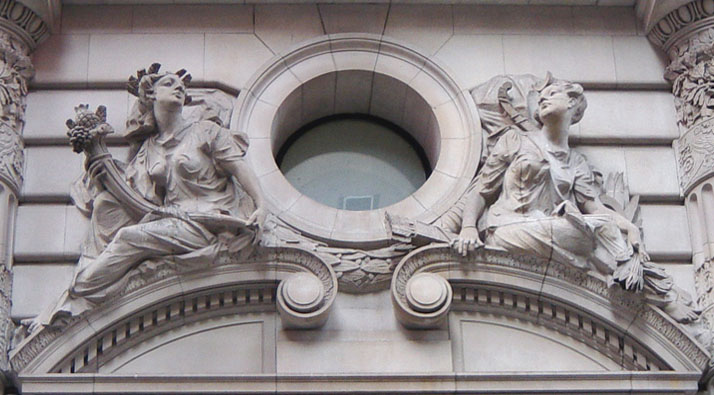|
Shrine Of The Báb
The Shrine of the Báb is a structure on the slopes of Mount Carmel in Haifa, Israel, where the remains of the Báb, founder of the Bábí Faith and forerunner of Baháʼu'lláh in the Baháʼí Faith, are buried; it is considered to be the second holiest place on Earth for Baháʼís, after the Shrine of Baháʼu'lláh in Acre. Its precise location on Mount Carmel was designated by Baháʼu'lláh himself to his eldest son, ʻAbdu'l-Bahá, in 1891. ʻAbdu'l-Bahá planned the structure, which was designed and completed several years later by his grandson, Shoghi Effendi. Crowning the design, as anticipated by ʻAbdu'l-Bahá, is a dome, which is set on an 18-windowed drum. That, in turn, is mounted on an octagon, a feature suggested by Shoghi Effendi. An arcade surrounds the stone edifice. A restoration project of the exterior and interior of the shrine started in 2008 and was completed in April 2011. History First mausoleum Bahá'u'lláh arrived in the Haifa-Akka region as a ... [...More Info...] [...Related Items...] OR: [Wikipedia] [Google] [Baidu] |
Palestine
Palestine, officially the State of Palestine, is a country in West Asia. Recognized by International recognition of Palestine, 147 of the UN's 193 member states, it encompasses the Israeli-occupied West Bank, including East Jerusalem, and the Gaza Strip, collectively known as the occupied Palestinian territories, within the broader geographic and historical Palestine (region), Palestine region. Palestine shares most of its borders with Israel, and it borders Jordan to the east and Egypt to the southwest. It has a total land area of while Demographics of the State of Palestine, its population exceeds five million people. Its Status of Jerusalem, proclaimed capital is Jerusalem, while Ramallah serves as its administrative center. Gaza City was its largest city prior to Gaza Strip evacuations, evacuations in 2023. Situated at a Levantine corridor, continental crossroad, the region of Palestine was ruled by various empires and experienced Demographic history of Palestine (region ... [...More Info...] [...Related Items...] OR: [Wikipedia] [Google] [Baidu] |
German Colony, Haifa
The German Colony (; ; ) is an area of Haifa established in 1868 during Ottoman rule as a German Templer Colonies in Palestine, Christian German Templer Colony in Palestine. It was the first of several colonies established by the group in the Holy Land. Others were founded in Sarona, Palestine, Sarona near Jaffa, Galilee and Jerusalem. Some of the original buildings are still surviving today, and the area continues to be visited, lived in, and in use.Karkabi, Nadeem.Expressions of Cultural Life in Post-1948 Haifa: Toward an Autonomous Palestinian Field" ''Interactive Encyclopedia of the Palestine Question.'' https://www.palquest.org/en/highlight/30052/expressions-cultural-life-post-1948-haifa History The Templers, a religious Protestant sect formed in southern Germany in the 19th century, settled in Palestine at the urging of their leader, Christoph Hoffmann, in the belief that living in the Holy Land would hasten the second coming of Christ. The Templers built a colony in kee ... [...More Info...] [...Related Items...] OR: [Wikipedia] [Google] [Baidu] |
Leroy Ioas
Leroy C Ioas (15 February 1896, Wilmington, Illinois - 22 July 1965, Haifa, Israel) was a Hand of the Cause of the Baháʼí Faith. His parents declared themselves Baháʼís in 1898 and took Ioas to meet ʻAbdu'l-Bahá during the latter's travels in the United States in 1912. Ioas moved to San Francisco after marrying Sylvia Kuhlman and soon became active in the local Baháʼí community. Service at the Baháʼí World Centre The head of the Baháʼí Faith in the first half of the 20th century, Shoghi Effendi, appointed Ioas to the International Baháʼí Council, precursor to the Universal House of Justice, in December 1951, where he served until 1961 as secretary-general. In order to fulfill his duties, he quit his job in the railway industry, where he had worked for nearly forty years, and moved to Haifa, where he would reside until the end of his life. He closely supervised the construction and completion of the Shrine of the Báb, for which Shoghi Effendi named the door ... [...More Info...] [...Related Items...] OR: [Wikipedia] [Google] [Baidu] |
Chiampo
Chiampo is a town and ''comune'' in the province of Vicenza, Veneto, Italy Italy, officially the Italian Republic, is a country in Southern Europe, Southern and Western Europe, Western Europe. It consists of Italian Peninsula, a peninsula that extends into the Mediterranean Sea, with the Alps on its northern land b .... It is on SP43. It houses the 19th-century Roman Catholic church of Santa Maria Assunta e San Martino and was the birthplace of the priest-poet Giacomo Zanella. Sources(Google Maps) Cities and towns in Veneto {{Veneto-geo-stub ... [...More Info...] [...Related Items...] OR: [Wikipedia] [Google] [Baidu] |
Granite
Granite ( ) is a coarse-grained (phanerite, phaneritic) intrusive rock, intrusive igneous rock composed mostly of quartz, alkali feldspar, and plagioclase. It forms from magma with a high content of silica and alkali metal oxides that slowly cools and solidifies underground. It is common in the continental crust of Earth, where it is found in igneous intrusions. These range in size from dike (geology), dikes only a few centimeters across to batholiths exposed over hundreds of square kilometers. Granite is typical of a larger family of ''granitic rocks'', or ''granitoids'', that are composed mostly of coarse-grained quartz and feldspars in varying proportions. These rocks are classified by the relative percentages of quartz, alkali feldspar, and plagioclase (the QAPF diagram, QAPF classification), with true granite representing granitic rocks rich in quartz and alkali feldspar. Most granitic rocks also contain mica or amphibole minerals, though a few (known as leucogranites) conta ... [...More Info...] [...Related Items...] OR: [Wikipedia] [Google] [Baidu] |
Baveno
Baveno is a town and ''comune'' in the province of Verbano-Cusio-Ossola, part of Piedmont, northern Italy. It is on the west shore of Lago Maggiore, northwest of Arona by rail. To the north-west are the famous red granite quarries, which have supplied the columns for the Cathedral of Milan, the church of San Paolo fuori le Mura at Rome, the Galleria Vittorio Emanuele at Milan Milan ( , , ; ) is a city in northern Italy, regional capital of Lombardy, the largest city in Italy by urban area and the List of cities in Italy, second-most-populous city proper in Italy after Rome. The city proper has a population of nea ... and other important buildings. One of the main attractions is a historic reach of villas and castles, built in the 19th century. Baveno was occupied in the pre-Roman Iron Age by the Lepontii, a tribe of the Ligures. Twin towns — sister cities Baveno is twinned with: * Nadur, Malta References External links Baveno.org [...More Info...] [...Related Items...] OR: [Wikipedia] [Google] [Baidu] |
Beaux-Arts Architecture
Beaux-Arts architecture ( , ) was the academic architectural style taught at the in Paris, particularly from the 1830s to the end of the 19th century. It drew upon the principles of French neoclassicism, but also incorporated Renaissance and Baroque elements, and used modern materials, such as iron and glass, and later, steel. It was an important style and enormous influence in Europe and the Americas through the end of the 19th century, and into the 20th, particularly for institutional and public buildings. History The Beaux-Arts style evolved from the French classicism of the Style Louis XIV, and then French neoclassicism beginning with Style Louis XV and Style Louis XVI. French architectural styles before the French Revolution were governed by Académie royale d'architecture (1671–1793), then, following the French Revolution, by the Architecture section of the . The academy held the competition for the Grand Prix de Rome in architecture, which offered prize winn ... [...More Info...] [...Related Items...] OR: [Wikipedia] [Google] [Baidu] |
Canadians
Canadians () are people identified with the country of Canada. This connection may be residential, legal, historical or cultural. For most Canadians, many (or all) of these connections exist and are collectively the source of their being ''Canadian''. Canada is a multilingual and multicultural society home to people of groups of many different ethnic, religious, and national origins, with the majority of the population made up of Old World immigrants and their descendants. Following the initial period of French and then the much larger British colonization, different waves (or peaks) of immigration and settlement of non-indigenous peoples took place over the course of nearly two centuries and continue today. Elements of Indigenous, French, British, and more recent immigrant customs, languages, and religions have combined to form the culture of Canada, and thus a Canadian identity and Canadian values. Canada has also been strongly influenced by its linguistic, geograph ... [...More Info...] [...Related Items...] OR: [Wikipedia] [Google] [Baidu] |
Architect
An architect is a person who plans, designs, and oversees the construction of buildings. To practice architecture means to provide services in connection with the design of buildings and the space within the site surrounding the buildings that have human occupancy or use as their principal purpose. Etymologically, the term architect derives from the Latin , which derives from the Greek (''-'', chief + , builder), i.e., chief builder. The professional requirements for architects vary from location to location. An architect's decisions affect public safety, and thus the architect must undergo specialised training consisting of advanced education and a ''practicum'' (or internship) for practical experience to earn a Occupational licensing, license to practice architecture. Practical, technical, and academic requirements for becoming an architect vary by jurisdiction though the formal study of architecture in academic institutions has played a pivotal role in the development of the p ... [...More Info...] [...Related Items...] OR: [Wikipedia] [Google] [Baidu] |
Port Of Haifa
The Port of Haifa ('';'' ) is the largest of Israel's three major international seaports, the others being the Port of Ashdod, and the Port of Eilat. Its natural deep-water harbor operates all year long and serves both passenger and merchant ships. It is one of the largest ports in the eastern Mediterranean in terms of freight volume and handles about 30 million tons of cargo per year (not including Israel Shipyards' port). The port employs over 1,000 people, rising to 5,000 when cruise ships dock in Haifa. The Port of Haifa lies north of Haifa's downtown quarter on the Mediterranean and stretches to some three kilometres along the city's central shore with activities ranging from military, industrial, and commercial next to a nowadays-smaller passenger cruising facility. History Haifa Bay has been a refuge for mariners since prehistoric times. When the Crusaders conquered Haifa in the year 1100, it became an important town and the main port for Tiberias, the capital of the G ... [...More Info...] [...Related Items...] OR: [Wikipedia] [Google] [Baidu] |





